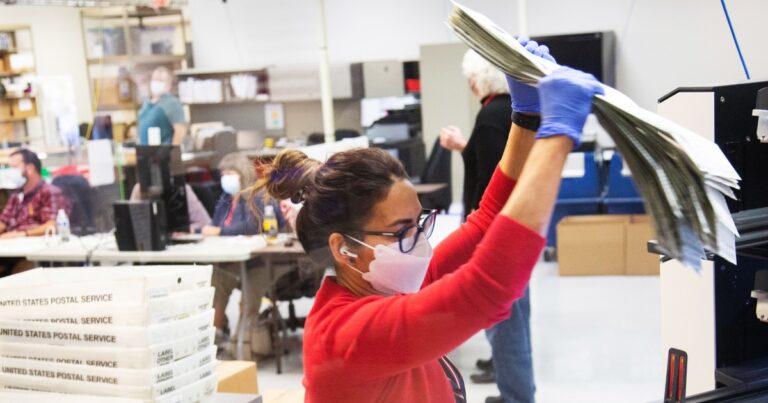PHOENIX — Maricopa County has been the epicenter of election conspiracy theories and denials of the results for the past two elections, and now the team running the polls is seeing how much a bigger effort to make the process more transparent and explainable could help.
In 2020, hundreds of pro-Trump protesters, some armed, gathered outside the Maricopa County Counting and Election Center in the days after the election, claiming without evidence that the election had been stolen from then-President Donald Trump.
In 2022, Republican gubernatorial candidate Kali Lake again fueled claims of election conspiracy theories after dozens of vote-counting machines malfunctioned, delaying the count.
And in 2024, the latest wave of election denialism is already brewing ahead of Tuesday’s primary election day.
In Maricopa County, one of the most closely-held states in the country, where more than 2 million people voted in 2020, a spate of misinformation, disinformation and noise surrounding the election has led county election officials to take steps to increase transparency at the Maricopa County Counting and Election Center. Maricopa County also invested about $15 million in new equipment to produce results faster and reduce skepticism about them.
One of the steps the Maricopa County Board of Supervisors has taken to increase transparency is adding surveillance cameras at the counting center so Arizonans can monitor the voting process from home. The new camera installation brings the total to more than 20, including monitoring drop box locations, seven different angles of the counting center, and four different angles where vote processing (verifying signatures on mail-in ballots before the ballots are counted) takes place.
All of these video angles will be available for live streaming 24/7 on the Maricopa County website.
“If the cameras weren’t on, people might say, ‘What’s going on when the cameras aren’t on?'” said Maricopa County Supervisor Bill Gates, who is not running for re-election in 2024 and said last year that he suffers from post-traumatic stress disorder after a string of harassment stemming from his elections role.
In an interview with NBC News, Gates detailed the county’s huge investments in election equipment beyond 2022. He said that of the $15 million in new equipment, $9 million is for new printers and $6 million is for new high-speed tabulating machines.
“One of the things that people have been asking questions about is how long it will take to count all of those ballots,” Gates said. “The investment in new, high-speed tabulating machines will speed up that process a little bit.”
The main obstacle to a speedy count is the large number of mail-in ballots that arrive just before or on Election Day. Each one requires signature verification, a time-consuming process. (In-person voters have their signatures verified when they check in at their polling place, allowing their votes to be counted more quickly.) Voting by mail has been popular in Arizona for years.
So far, Maricopa County’s efforts toward efficiency and transparency have not quelled the latest wave of skepticism. After a former Maricopa County elections official was accused of stealing security fobs from a voting center, jewelry from a museum, and several items from the state Capitol, Arizona Republican Party Chair Gina Swoboda appeared to suggest the incident was part of a conspiracy to reduce Republican voter turnout.
“I’m beginning to suspect that people are intentionally undermining confidence and not protecting the system so that people are going to give up and not vote,” Swoboda said in a local news interview in late June. He then threatened the Maricopa County Board of Supervisors.
And after the CrowdStrike outages earlier this month that affected early voting locations in Arizona, flight reservations and other swaths of American life, the Republican National Committee and the Arizona Republican Party sent a letter to the Maricopa County Board of Elections demanding answers.
“We have a job to do, and we can’t do our job of running an election without strong partnerships with the major parties,” Gates said of Swoboda’s comments.
“If they say something irresponsible and false, we’re not going to go off the deep end,” Gates added.
Perhaps the most vocal proponent of election-related conspiracy theories in the state is Lake, who is seeking the Republican Senate nomination on Tuesday. Lake made unfounded claims of election fraud after losing the gubernatorial race to current Gov. Katie Hobbs two years ago and has made attacks on Maricopa County elections part of his campaign this term.
“If Mohave County participates 100 percent, or close to it, there’s no way Maricopa County can get away with cheating no matter what,” Lake said at a rally in Mohave County this spring. “You know the garbage they’re pushing out there,” he added.
“Maricopa County is lawless, it’s corrupt and there’s no accountability,” Lake said in a local radio interview in May.
The uproar and false allegations have taken a toll on Gaetz and others involved in Maricopa County’s election campaign.
“You know, over the last four years we’ve dealt with death threats,” Gates said.
“There are people within our own party who claim we are traitors and that we are trying to steal the election, and that’s very frustrating,” Gaetz, a lifelong Republican, added.
Besides Gaetz, another election official facing brunt in Maricopa County is Steven Richer, who is up for reelection this year and faces a Republican primary on Tuesday. In June, Richer posted a video on X in which he said Arizona Republican National Convention chair Shelby Bush would “lynch” him if she had the chance. The video was from a March 20 livestreamed event in Mesa on the conservative video platform Rumble.
Gates hopes Arizonans remember the humanity behind the work being done.
“These are not faceless bureaucrats. They’re not just machines doing this job,” Gates said. “These are thousands of people here who live in Maricopa County, our aunts, uncles, mothers, fathers, grandmothers, grandfathers. We owe it to them to let people know the facts and the good job they’re doing.”


